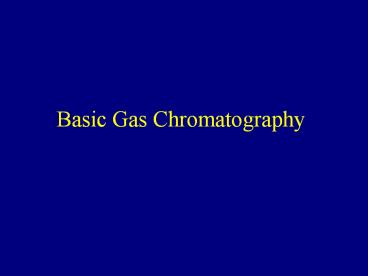Basic Gas Chromatography - PowerPoint PPT Presentation
Title:
Basic Gas Chromatography
Description:
Basic Gas Chromatography What do you need? History 1850 - Separation of dyes by Runge 1906 - Separation of plant pigments by Tswett 1941 - Theoretical gc (Martin ... – PowerPoint PPT presentation
Number of Views:1285
Avg rating:3.0/5.0
Title: Basic Gas Chromatography
1
Basic Gas Chromatography
2
History
- 1850 - Separation of dyes by Runge
- 1906 - Separation of plant pigments by Tswett
- 1941 - Theoretical gc (Martin Synge)
- 1952 - First gc
- 1954 - TC detector
3
Process
- Sample is vaporized (if it is not already a
vapor) - Passes through a column where interaction occurs
- does analyte move with gas phase or stay with
stationary phase (column coating) - Separation occurs
- Detection - many types of detectors
4
- High purity!
- Source of mobile phase - He or H
- Detector gases - none or air/H (Flame ionization
detector)
5
Gas flow regulators
- Pressure regulators - stainless steel parts - not
welding quality! - Flow regulators - Determine gas flow rates
through system (sensitive precision instruments)
6
Injection port
- Introduce sample
- Vaporize sample
- Split sample (?)
7
(No Transcript)
8
Injection ports - many versions
- Split - only a portion of injection goes on
column - Splitless - all material injected goes on
column - On-Column - cold injection (sensitive materials)
- Programmed temperature - sensitive materials
(more durable method than OC) - Large volume - Can inject 1 ml - solvent removal
9
Columns
- Packed (hard to find)
- Capillary (generally open tubular but can be a
wall coated PLOT type)
10
Columns
- Generally fused silica - strong and inert
- Inner diameters - 0.10 - 0.53 mm
- Length - 1 - 60 m
- Coatings - several - range in thickness from 0.1
- 5 um
11
Common Stationary Phase Coatings
12
Phase selection
- PUBLISHED INFORMATION
- Kovats indices compilations
- Journal articles
- Internal work
- INTUITION
- like structures
- NO IDEA?
- Sample information
- Nonpolar column
- Change to polar if needed
13
Separation theory
- 1. Adsorption
- 2. Molecular exclusion
- 3. Partition
- 4. Vapor pressure
14
Adsorption chromatography
- Interaction with a granular support e.g. Tenax,
charcoal, silica gel,
15
Molecular exclusion
- Used for the separation of permanent gases e.g.
Zeolites, Linde molecular sieves
16
Partition chromatography
- Partitioning between mobile phase and carrier gas
vapor pressure - SEPARATION BASED ON THE BOILING PT
17
Column coatings (stationary phases)
- Polar to nonpolar
- Polar - Carbowax
- Non Polar - silicone based phases
18
Column ovens
- Usually heat ovens to help in separations
- Ovens can be controlled from about -60 - 400C
19
Detectors
- Many types varying in sensitivity and selectivity
- Discuss most common types
20
Thermal conductivity detector
21
Characteristics of TC detector
- Specificity - very little - will detect almost
anything including H2O - called the universal
detector. - Sensitivity to 10-7 grams/sec - this is poor -
varies with thermal condition of the compound. - Linear dynamic range 104 - this is poor -
response easily becomes nonlinear.
22
Flame ionization detector
23
Characteristics of a Flame Ionization Detector
(FID)
- Specificity - most organics.
- Sensitivity - 10-12 g/sec for most organics --
this is quite good. - Linear range 106 - 107 -- this is good.
- A special type of FID is called an alkali
flame (AFID). Rubidium sulfate is burned in the
flame and the detector becomes specific for N and
P. Organics are not detected. Used for amines and
nitrosoamines. (more commonly called the NPD)
24
Electron Capture Detector
25
Characteristics of an ECD
- Specificity - sensitive to halogens, conjugated
carbonyls, nitriles, and a few others - no
response with ordinary organics or H2O. - Sensitivity 5 x 10-14 g/sec - excellent
- Linear range 104
- The radioactive detectors have definite
temperature limits.
26
Separation - terms
27
RESOLUTION
28
- SELECTIVITY relative interaction of column
stationary phase with both compounds to be
separated - ? tr2
- tr1
- CAPACITY retention time of compounds to be
separated - k tr - tm tr
- tm tm
- THEORETICAL PLATES column EFFICIENCY
- n 5.545 (tr/Wh)2
29
Optimizing Gas Chromatography
30
Key factors influencing efficiency in gas
chromatography are column phase (nonpolar are
most efficient) and column diameter.
31
Carrier gas type and velocity
32
Phase thickness
- Capacity and Efficiency influenced by column
diameter and phase thickness - Thick phase capacity
- Thin Phase less capacity
33
Column length
- Longer means better separations but longer
analysis times - Time proportional to length
- Separation proportional to sq root of length
- Poor means of getting separation costs too much
in time. Use diameter, phase thickness or phase
type
34
What do you need?
35
THANK YOU









![Lecture note : Gas chromatography [1] ????????? PowerPoint PPT Presentation](https://s3.amazonaws.com/images.powershow.com/6692254.th0.jpg?_=20150604093)




![Lecture note : Gas chromatography [2] ????????? ??? PowerPoint PPT Presentation](https://s3.amazonaws.com/images.powershow.com/6741367.th0.jpg?_=20150612015)




![Lecture note : Gas chromatography [1] ????????? PowerPoint PPT Presentation](https://s3.amazonaws.com/images.powershow.com/4420183.th0.jpg?_=20131029062)


![Lecture note : Gas chromatography [2] ????????? ??? PowerPoint PPT Presentation](https://s3.amazonaws.com/images.powershow.com/4668905.th0.jpg?_=20131120112)








